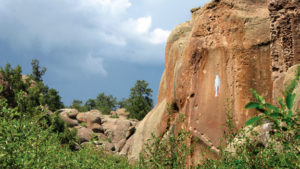by Susan Tweit
One of the wonders of nature, as I see it, is all we don’t know about the world around us, the everyday relationships and behaviors of species large and small that fly, swim, run, crawl, slither, and root in earth and sea.
Take, for example, a recently published study that elicited this tongue-twisting headline in Science News, “Sea slug steals genes for greens.”
The story by Susan Milius reports on research suggesting that Elysia chlorotica, a species of sea slug, a kind of marine gastropod distantly related to slimy land slugs, can make its own chlorophyll, the green pigment that plants use to manufacture their own sugary food using the sun’s energy.
What’s the big deal about that? If the leaf-shaped sea slugs have indeed “stolen” the genetic mechanism for making chlorophyll and are producing sugars inside their cells with solar energy, they are the only known photosynthesizing animal. Until now, photosynthesis, the process that feeds plants, and by extension, the rest of life on Earth, has been considered exclusively a plant thing.
The story of how Elysia chlorotica, a small, bright green creature that looks something like an oval leaf with a fleshy head bearing two slug antennae may have acquired the ability to make chlorophyll is almost as bizarre as the feat itself.
Elysia chlorotica, which like millions of species has no common name, is a marine grazer. This unusual shell-less gastropod spends its days swimming by rippling the margins of its flattened body, and noshing on filamentous green algae — the mats of green slime that cover rocks, pilings, boat hulls, and other marine surfaces.
The sea slug sucks the innards out of the algae, and in the doing, acquires the equipment for photosynthesis, the chloroplasts and the green pigment they use to make the solar-energy-powered, sugar-making process happen.
Elysia chlorotica is not the only animal to procure the food-making process from plants: coral, for instance, ingest algae whole and secrete them in pockets in coral bodies, thus acquiring their own live-in food-producers.
(When coral “bleach,” what actually happens is the algae within the coral die and the pigment the algae had been synthesizing to make food leaches away, causing the coral to lose the coloration lent by their “tenants”; without their food, the coral starves to death.)
Lichen are another case of borrowed or coerced food-making: a fungus kidnaps an alga or photosynthesizing bacteria; enmeshed in sticky fungal threads, the partner is both sheltered from the elements and unable to escape feeding its “protector.”
What Elysia chlorotica is apparently doing goes one step farther. In slurping up the equipment for making its own food from the algae mats, the sea slug also acquires the alga’s genetic instructions the algae uses for photosynthesis.
Elysia then apparently uses that green coding to synthesize its own chlorophyll and produce its own sugars using solar energy, thus giving the little sea slug not only its bright green color, but the ultimate form of food independence as well, photosynthesis.
Copyright 2010 Susan J. Tweit. Originally published in the Salida Mountain Mail.
Award-winning writer Susan J. Tweit is the author of 12 books, and can be contacted through her web site, susanjtweit.com or her blog, susanjtweit.typepad.com/walkingnaturehome

